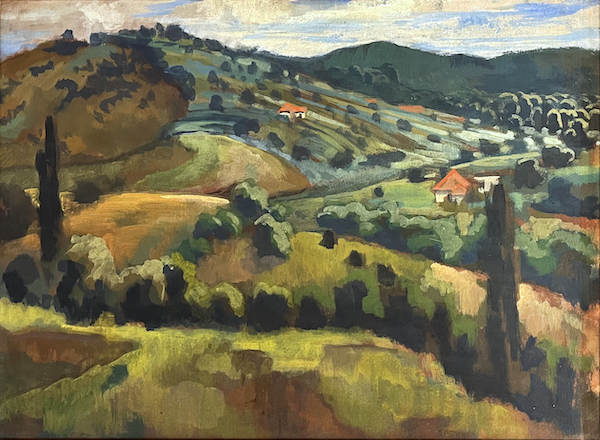Biography
In the academic year 1914-1915 he enrolled at the Graphische Lehr- und Versuchsanstalt K. u. K. in Vienna, where he was taught the (then) techniques of photography from the end of the 19th century, while he also worked in a factory as a zincographer. In 1917, he was called up as a soldier and fought with the 61st Timisoara Infantry Regiment on the Doberdo front, forcing him to interrupt his studies. After the war, in 1918, he spent a few months as a student at the School of Applied Arts in Budapest, where his master was Jenő Haranghy. In 1919 he travelled to Vienna with the intention of studying at Johannes Itten's private school, but when Itten left for Weimar the school closed. In 1920 he held his first exhibition, which dealt with the miseries of war. He met Béla Uitz and Robert Berény, and joined the efforts of the group of artists around Der Sturm. Between 1920 and 1923, he was a student of metalwork at the State Bauhaus School of Art in Weimar, led by Walter Gropius. From 1923 he worked as a lithographer, painter and photographer in Cluj-Napoca and Sibiu until 1926. He published a journal on the natural way of life entitled Life Science. He was then invited by Johannes Itten to become a teacher at his new art school in Berlin, the Moderne Kunstschule (from 1929 Ittenschule), where he taught until 1934. Around 1933 he produced advertising graphics in collaboration with László Moholy-Nagy. In 1933, his graphic work was shown in Utrecht and The Hague. He returned to Hungary in 1934, settled in Budapest and became a textile designer at the Goldberger Factory in the second half of the 1930s. He also taught the workers of Lajos Kassák's Munkakör. Between 1946 and 1949 he was the organizer and director of the Nagy Balogh School of Painting and Folk College in Nagymaros. He was also a member of the Socialist Artists' Group. Between 1949 and 1962, he taught at the College of Fine Arts, and generations of artists grew up under his tutelage.
His art cannot be classified into any single stylistic category. Initially, the avant-garde and the Bauhaus influenced his graphics and object design. During the first half of his time in Weimar, he made vases and jugs from a combination of copper, copper and silver. His metal objects from around 1922 (an electric samovar in metal and glass, a floor lamp with diffused light) were already in the direction of modern design. One of his earliest surviving works, Old Woman, is a delicate cold relief drawing with some Art Nouveau features. He painted from the early 1920s. From the second half of the decade onwards, his painting was characterised by a more austere, geometric formalism and a more rigid pictorial structure. In his works from 1928 to 1930, the outlines of the forms of objects are blurred and given a surreal effect by the light emanating from within them. Around 1934, his individual painting style, based on large, summary forms, later developed into a visionary, surrealistic style. Between 1934 and 1945, he travelled the countryside constantly, painting people and landscapes in and around Szentendre, Zebegény and the Danube Bend. His landscape painting also changed, he shaped the landscape with strong contours. In addition to his landscape and still life paintings, his favourite subject was the depiction of the movement of a man doing manual labour. From the 1940s onwards, the realistic depiction of hard, manual labourers: blast furnace workers and blacksmiths became one of his favourite subjects, and he painted in factories. It was at this time that he developed a highly constructive structure, but at the same time a dynamic, strongly contoured art, which became monumental in his formal compositions. From the second half of the 1950s until the end of his career, landscapes and still lifes, such as the Sea series, which was launched at the same time as the international ecological movements, played a major role in his oeuvre. From the 1960s onwards, he created playful compositions with a rhythmic effect, using elements from the non-figurative medium, as well as floral still lifes and works based on everlasting symbols. His painting became more playful in the 1970s, with a renewed emphasis on abstract, rhythmic forms. He also taught in his studio and organised studio exhibitions for his students.
Photography is an important part of Gyula Pap's art. He took his first photographs as a child in the Vienna area, and then as a soldier during World War I. After completing his studies in Weimar, he took a series of photographs in 1924 in the Southern Great Plain and the Banat, and it was here that he produced his 'sociographic' pictures, in which he captured the way of life of people (Hungarians, Romanians, Swabians, Gypsies) in Timisoara. Between 1926 and 1933, as a teacher at the Itten Schule in Berlin, he enriched the so-called Bauhaus photography. After returning to Hungary in early 1934, he photographed the vine-growers of the Danube Bend, Palócföld and the northern Balaton mountains, Csopak and Szigliget, and then, in parallel with his painting subjects, he turned to industrial work, especially metallurgy. In his last pictures, in the 1960s, he depicted endangered species of nature, trees, water, rocks. Posthumously, his photography has received increasing international recognition, exhibitions and publications.

